Follow this year's Engineering/MBA Dual Degree International Study students as they visit global businesses and industrial sites and immerse themselves in different cultures and historical sites. Below is a their 2018 Itinerary followed by blog posts.
- May 10 - Thurs: Munich- Arrival, Acclimation & Cultural Panoramic Tour
- May 11 - Fri: Munich- Olympic Stadium | Allianz Stadium |Group Dinner
- May 12 - Sat: Munich- Tour of Dachau Concentration Camp | Free Afternoon
- May 13 - Sun: Munich- Salzburg Day Trip
- May 14 - Mon: Munich- Palo Alto Networks| Apaleo | Transfer to Barcelona
- May 15 - Tues: Barcelona- Cultural Tour
- May 16 - Wed: Barcelona- Microsoft | Scytl
- May 17 - Thurs: Barcelona- Grifols | Freixenet | Group Dinner
- May 18 - Fri: Barcelona- Free Day
- May 19 - Sat: Transfer to Prague
- May 20 - Sun: Prague- Cultural Tour
- May 21 - Mon: Prague- Bell Helicopter | Free Afternoon
- May 22 - Tues: Prague- LA Composites| Eli-Beams | Dinner Cruise
- May 23 - Wed: Program End
Day 1

Halo from München!
Our group finally made it safe and sound to Munich, after many hours of travel.
We began our experiences in the city on a guided tour spearheaded by the knowledgeable Hildrun. Our walking tour took us past several historic landmarks in the city, including the Residenz, home of Bavarian rulers of ages past; into the Englischer Gartens, one of the largest public parks in the world; and through Marienplatz, which houses Neues Rathaus, the new city hall. We were also able to get out and walk around the Nymphenburg Palace (pictured below), the summer home of the Bavarian rulers of House Wittelsbach.
By bus we were able to see all that Munich has to offer, from the museum district down through the university student section. The group got several suggestions for where to go on our free afternoon of exploration, including the Lenbachhaus, a residence-turned museum full of Munich paintings; Pinakothek der Moderne, a modern art museum; and Neuschwanstein Castle, previous home of King Ludwig II of Bavaria and the inspiration behind Walt Disney World's famous Sleeping Beauty's castle. We were also able to drive by the area the city utilizes during the annual Oktoberfest celebration, and learn about the six major Munich breweries that offer beer at the festival.
Tomorrow we'll begin our day bright and early with a tour of the Olympic Stadium, followed by a tour of the Allianz Stadium, home to FC Bayern.
Day 2
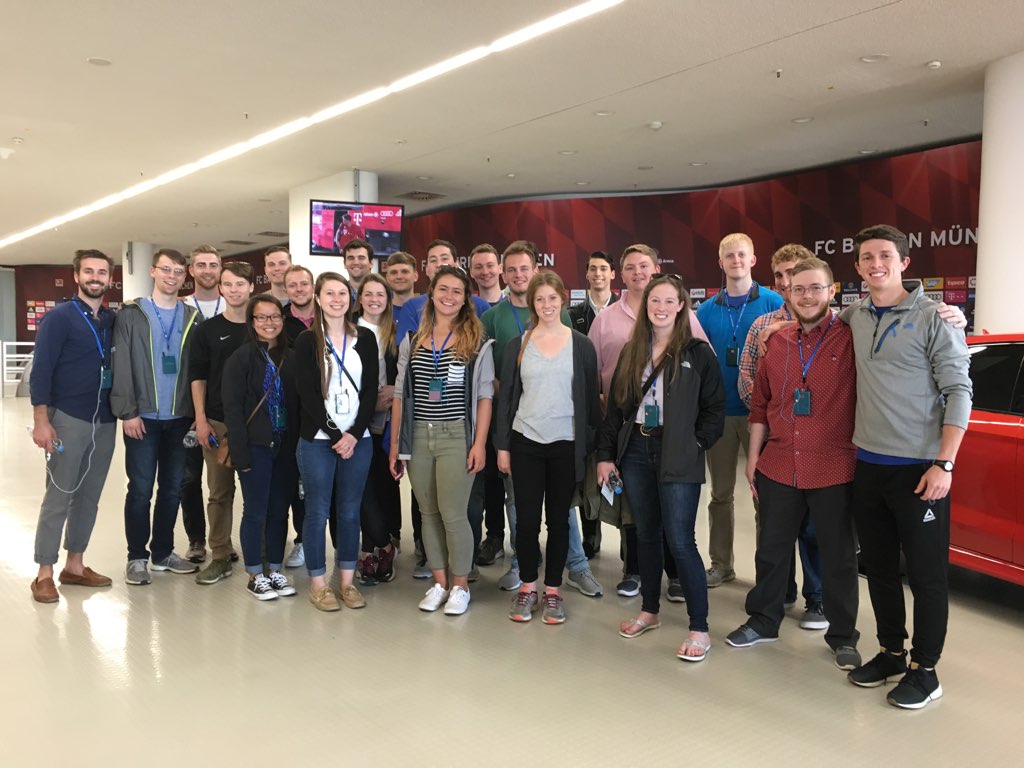
Today marks the beginning of our site visits in Munich! We started the day with a walking tour of Olympiapark, home of the 1972 Summer Olympic Games. The complex consists of a large urban park, the Olympic Stadium, and 5,000 athlete apartments. Our group was fortunate enough to be able to set foot in the stadium to run a few laps on the track and play some football. It was intriguing to learn about the unique tent structure covering the facility, an amazing feat of architecture constructed without the use of a computer. Our guide Daniel told us the whole complex and the associated S-bahn took only 6 years to build.
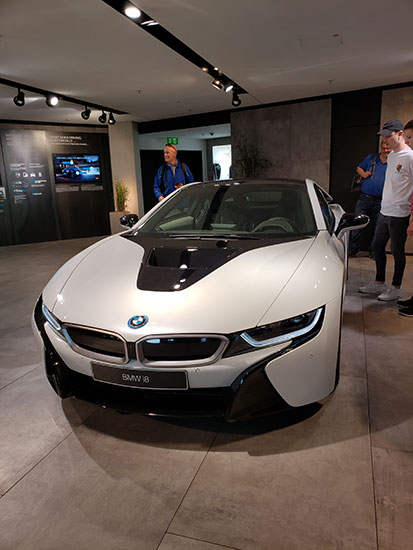 We then spent time exploring the BMW Welt, an exhibition center used to display BMW products, including the Rolls Royce and Mini Cooper brands. Our group got the opportunity to explore all the current models of cars (including an i8, pictured here) and motorcycles the company offers.
We then spent time exploring the BMW Welt, an exhibition center used to display BMW products, including the Rolls Royce and Mini Cooper brands. Our group got the opportunity to explore all the current models of cars (including an i8, pictured here) and motorcycles the company offers.
Our second site tour was of the Allianz Stadium, home to FC Bayern, one of Munich's two football teams. Our class got an in-depth tour of the grounds, including the locker areas, 75,000-seat stadium, and attached museum. The group photo included was in the exit hallway where the players walk before traveling elsewhere to play.
We finished our day with a hearty meal at Zum Augustiner, a restaurant and beer hall that serves traditional German fare. This was the first time many of us were able to venture out and try true Bavarian dishes, including leberkaes and weisswurst. All the food was delicious and our group left extremely full!
Day 3
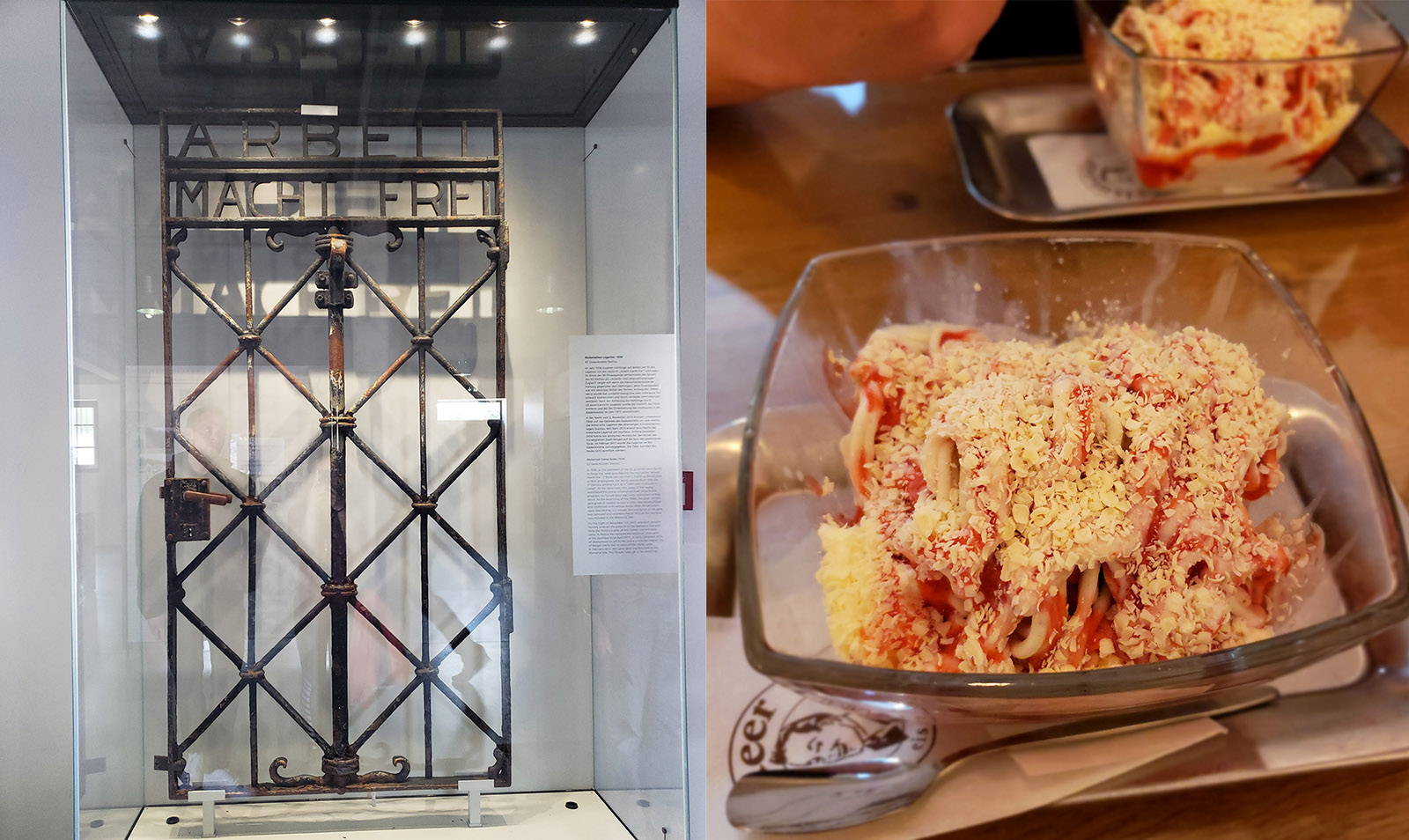 Today began a somber and impactful day as our group traveled to nearby Dachau to visit the Nazi concentration camp. Hildrun informed us of the history of the camp, and educated us on the atrocities committed here. Dachau was the first concentration camp, intended originally to house political prisoners. Our group made the solemn journey through the entrance gate (pictured here), where the phrase "Arbeit Macht Frei" is inscribed, meaning, "work makes you free". We toured the grounds, including the two recreated barracks, the standing cells, the crematorium, and the on-site museum, which houses the room where prisoners were initially processed into the camp.
Today began a somber and impactful day as our group traveled to nearby Dachau to visit the Nazi concentration camp. Hildrun informed us of the history of the camp, and educated us on the atrocities committed here. Dachau was the first concentration camp, intended originally to house political prisoners. Our group made the solemn journey through the entrance gate (pictured here), where the phrase "Arbeit Macht Frei" is inscribed, meaning, "work makes you free". We toured the grounds, including the two recreated barracks, the standing cells, the crematorium, and the on-site museum, which houses the room where prisoners were initially processed into the camp.
We learned of the medical experimentation that occurred in barrack 3, where the SS tortured prisoners to study the effects of hypothermia. Our group spent a good deal of time wandering the museum, reading about the histories of those persecuted at Dachau.
Our group stayed in Dachau for lunch at Gaststatte, a biergarden nearby. We had plenty of leftovers from the dinner before, and were grateful for the beautiful weather we enjoyed.
With our free afternoon, the group got a chance to explore Munich independently. Some visited the Deutsches Museum, the world's largest collection of science and technology, while others opted for shopping and wandering the city's unique neighborhoods. One group visited Hofbrauhaus Munich, a 16th-century beerhall for dinner. Some of us found spaghetti eis at a local ice cream shop (pictured here); a perfect way to end the day.
Day 4
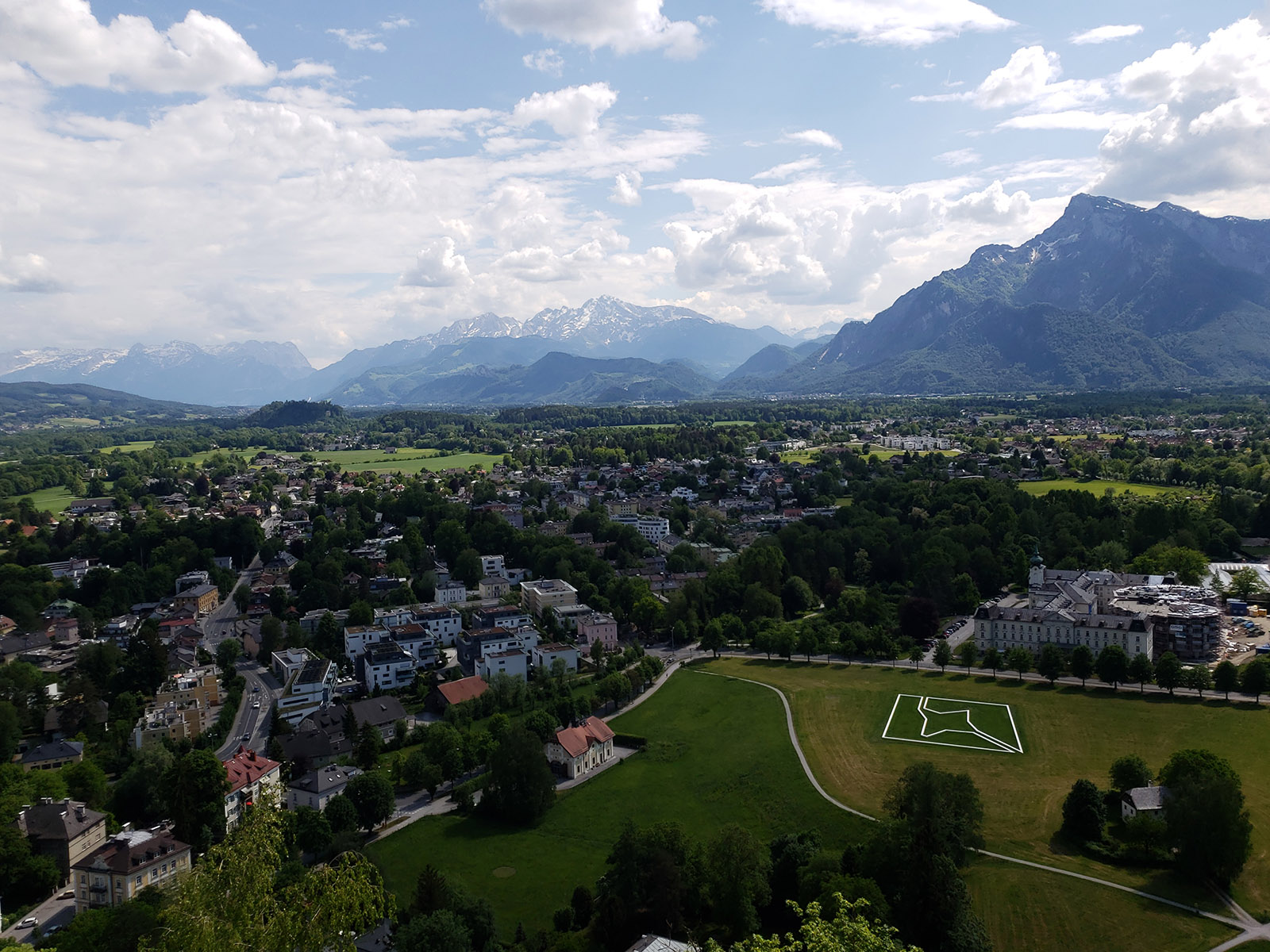
Happy Mother's Day to all the moms back home in the US! Know that the group is thinking of each of you today.
After a quick train ride, our group arrived to spend the day in Salzburg, Austria. The city's name comes from the salt barges that used to travel down the nearby Salzach river, and literally translates to "salt castle". It's Austria's fourth largest city and the birthplace of Wolfgang Amadeus Mozart. During our cultural tour we got to hear of the history behind the town, in addition to learning about some of the landmarks in the city. The group explored Mirabell gardens and enjoyed some live Austrian music.
Salzburg was also the backdrop for the movie The Sound of Music. Hilderun, our guide, pointed out many infamous spots where filming took place, including the fountain where the song "Do-Re-Mi" was shot. We concluded our day with a tour of the Festung Hohensalzburg, the city's fortress. We rode up the Festungsbahn, the fortress's funicular to begin our tour. The audio guide walked us through the castle's development and construction throughout the years, starting in 1077 when Archbishop Gebhard began construction. The group was able to see the torture chambers, look-out tower and the mechanical bull, a medieval organ. The tower on the roof offered spectacular views of the city, including the Austrian Alps (pictured). Our ticket also included entrance to the fortress museum, which some of us explored later in the day.
Tomorrow is our last day in Munich, as we conclude our stay with a few company visits and a flight to Barcelona.
Day 5
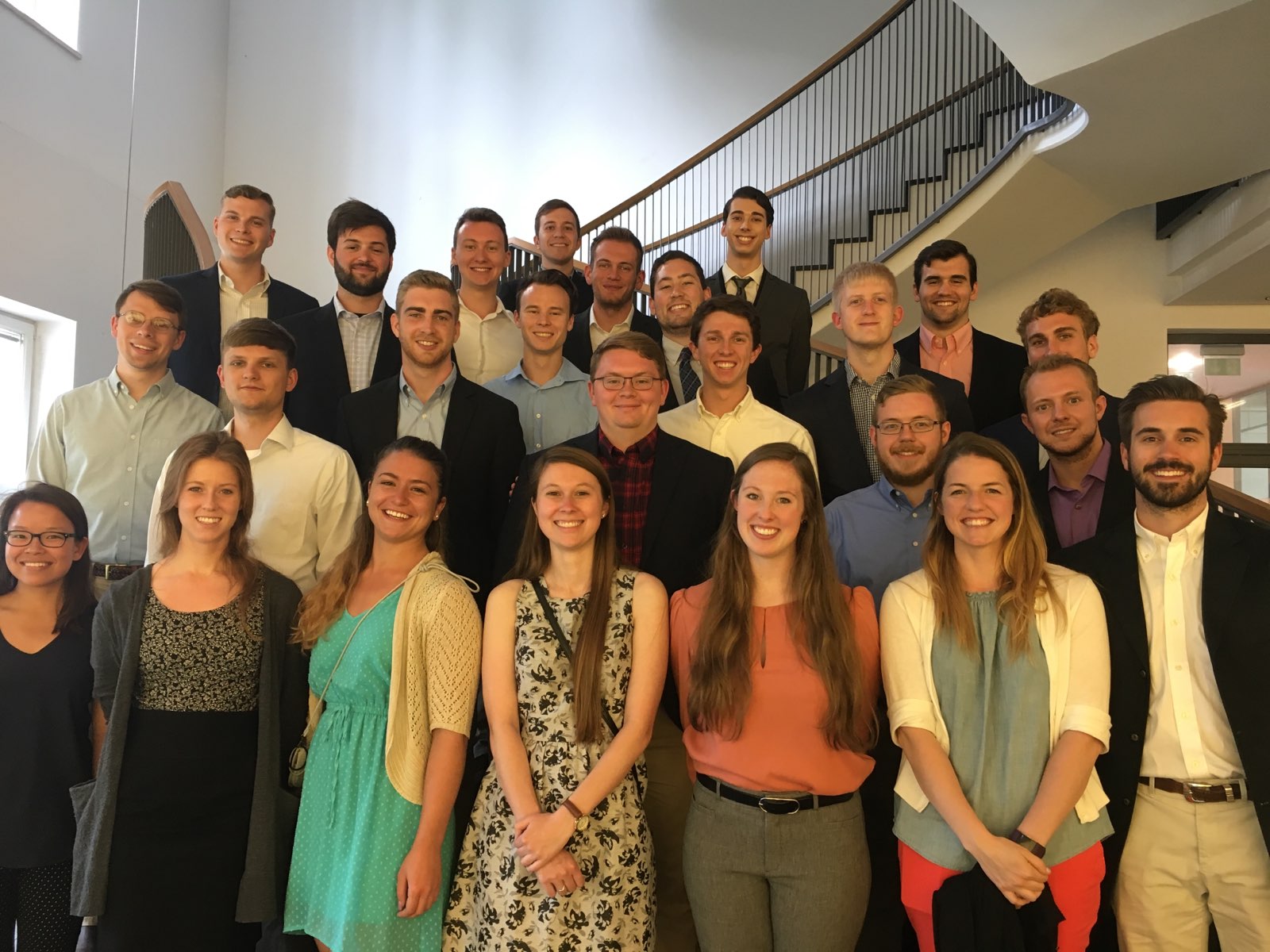
We started our company visits at Palo Alto Networks, a California-based cybersecurity software development specialist. Of the company's 5,000 employees, about 100 are based out of Munich. We learned about the high-level marketing strategy the company utilizes to target customers, what the speakers look for in future employees, and the biggest challenges facing the industry today. One of our guest speakers, Frank Koemel, spoke of the cultural differences between doing business in different regions of Germany (Bavaria vs Hamburg), Austria, and Switzerland. He educated us on best practices for his company, including having locals sell to local clients.
Our second visit was to Apaleo, a tech startup company here in Munich. One of the founders, Stephan Wiesener, told us about his career within the technology industry and of how Apaleo came to be. Stephan had previously sold off startup divisions to TripAdvisor. Apaleo currently works on developing software solutions and application platforms for the hotel industries in Europe. Their services range from booking logistics to revenue record keeping and transaction handling. The company officially launched about a year ago and already has over 40 clients. Apaleo employs around 20 people, most of whom are coders. Stephan hopes the company is able to build a name for itself in Europe, and then eventually expand into the United States. The namesake of the company is an ode to the lion (leo) Bavaria is fond of and the street the business is located on: Leopoldstrasse. The group picture shows our class in the building Apaleo is housed in.
/p>After the company visits the group headed to the airport to board the plane to Barcelona. We checked into the hotel and had free time to grab dinner. Most of us ventured downtown using the metro system, to try out tapas or walk around the cafes. Tomorrow we'll get a cultural tour and familiarize ourselves more with the area.
Day 6
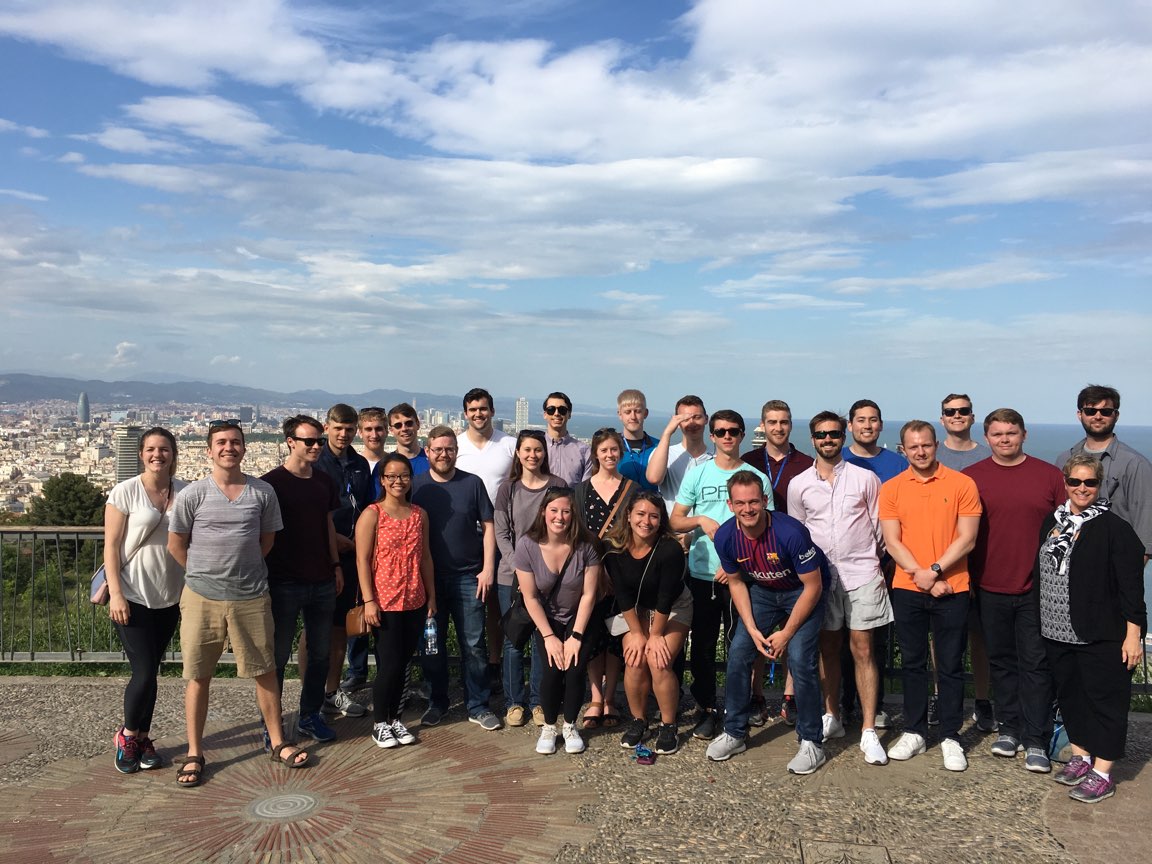
Buenos días from España!
Today our group got the chance to explore Barcelona through a day-long cultural tour.
We started our trip at a city staple: Park Güell. This municipal park was originally designed by the renown Antoni Gaudí, the architect behind many works in Barcelona. We had a reserved admission for the monument regions of the park and were able to explore some of the notable park works, including mosaic benches.
From the park, our group travelled to another famed Gaudí work: La Sagrada Familia. Gaudí was the second to work on the construction of the Catholic Church, after the original architect passed away. It is perhaps one of the most famous incomplete churches in the world, recognizable by its distinct design (pictured here). Our tour guide informed us that Gaudí spent the last twelve years of his life solely devoted to this one project. Construction began in 1882 and is set to complete in 2030. Pope Benedict XVI consecrated the church in 2010, and services have been held within the building ever since.
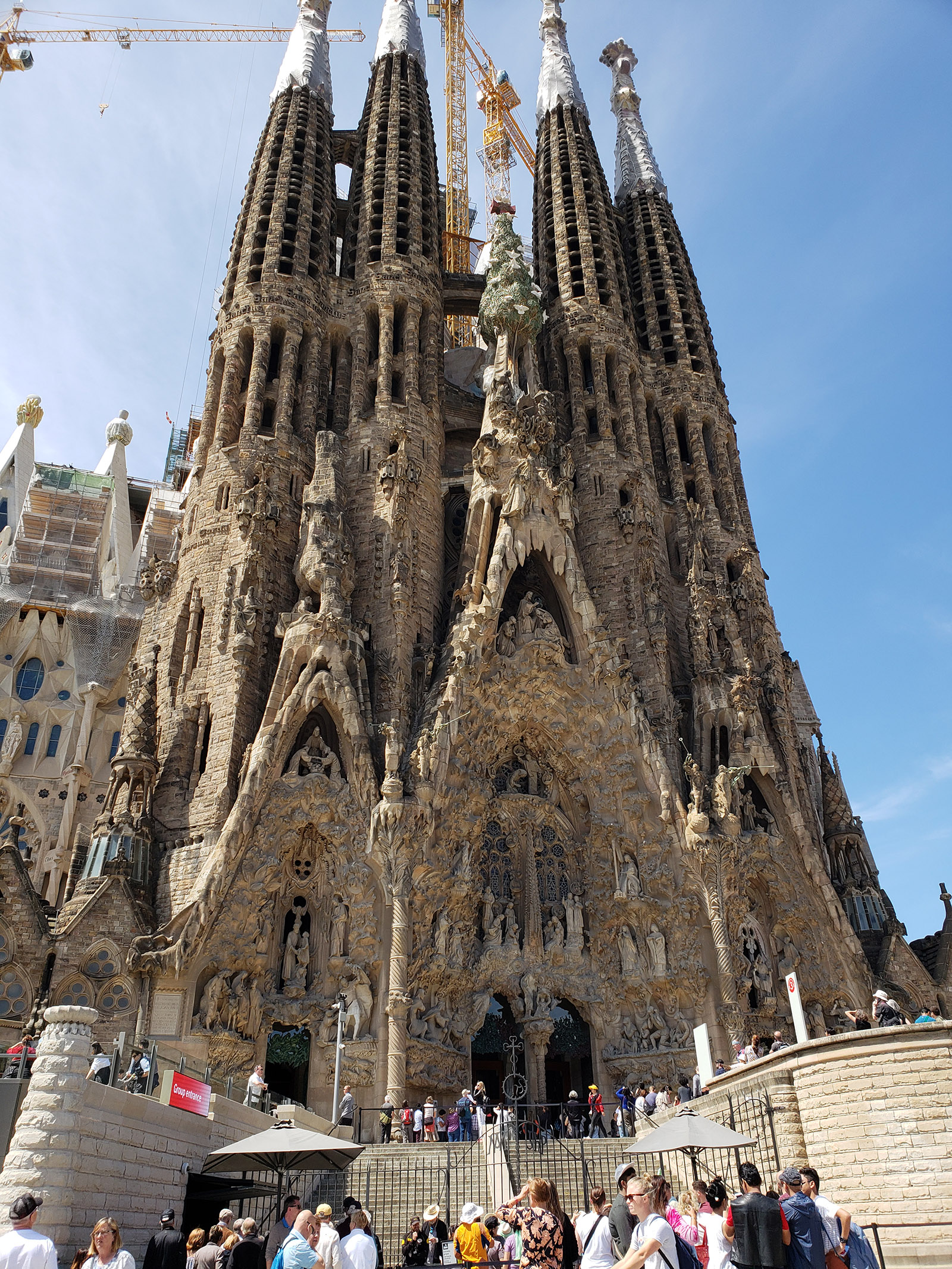 Next stop was another Gaudi construction: La Pedrera, or Casa Míla. It was the last private residence Gaudí ever designed. Our group got to tour the inside of the apartment complex, including wandering around the rooftop (pictured here) which afforded us a panoramic view of the city. We also had access to the museum, which houses models of Gaudí's other works and showed photos of how the furniture probably looked in the apartments.
Next stop was another Gaudi construction: La Pedrera, or Casa Míla. It was the last private residence Gaudí ever designed. Our group got to tour the inside of the apartment complex, including wandering around the rooftop (pictured here) which afforded us a panoramic view of the city. We also had access to the museum, which houses models of Gaudí's other works and showed photos of how the furniture probably looked in the apartments.
Mont Juïc was our last stop of the day. It's one of Barcelona's many hills situated in the southwest section of the city. Our group enjoyed the expansive views of the harbor from this vantage point.
Day 7
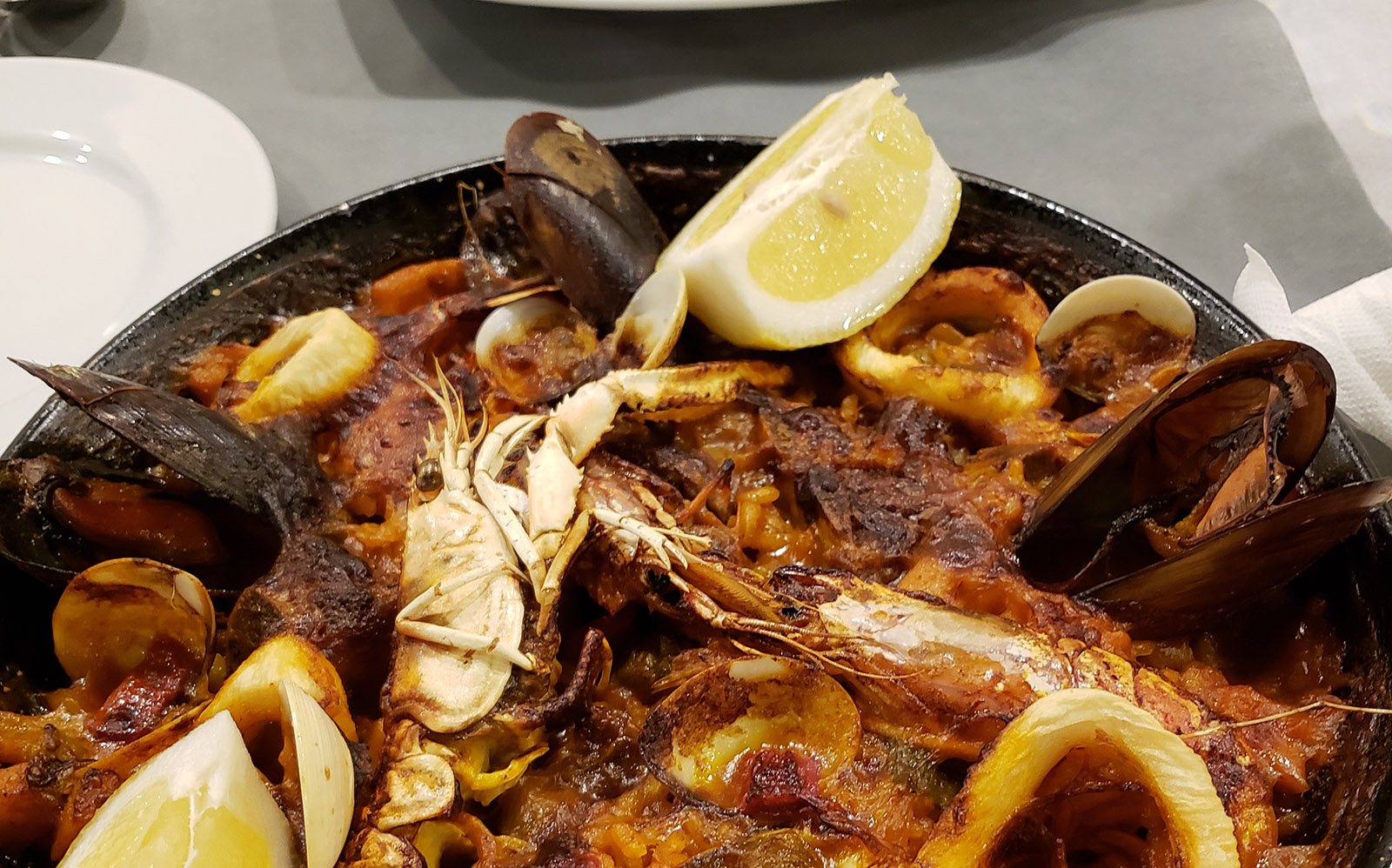
Day 7 marks the official halfway point of the program, which is flying by unbelievably quickly. Our group began the day with the first Barcelona company visit. Our guest speaker, Chandru Shankar works for Microsoft as the Manufacturing Industry Director for EMEA. He spoke on digital trends and their impact on the manufacturing industry. The group took away important insights about technology in the future, including examples of how Microsoft's software solutions are allowing companies to utilize data smartly and efficiently. Microsoft partners with companies like Renault Sport, Nissan, Rolls Royce and Marston's to help each reach their fullest potential in terms of bringing their customers the best possible experience.
Chandru spoke about the five tech's of the future that will shape the industry, including IoT, AI, advanced robotics, AR/UR, and 3D printing. Chandru also shared his experiences of working internationally with the group, and encouraged all of us to pursue this type of cultural immersion at least once in our careers. His helpful and candid career advice will most definitely prove useful for those of us who end up abroad at some point with our jobs.
For lunch the group had free time to continue exploring Barcelona's extensive food scene. Some of us walked to a nearby shopping mall that inhabits a previous bull arena. Many adventurous souls opted for paella, a Spanish rice dish with seafood and other meats (pictured here).
Our second company visit was to Scytl. The company provides electronic solutions for public and private elections around the world. Our speaker, Gwendolyne, focused her talk on global market trends in the elections technology industry. She spoke of Scytl's evolution as it has expanded operations across the globe, and what that's meant for the business in terms of the different strategic entry decisions the company has had to make. Gwen showed us a video explaining what their solutions can do for the general populace, specifically in regards to allowing those with physical or visual disabilities to vote anonymously. The group learned a great deal about what the elections industry can improve upon, and how radical technologic developments can improve the current process.
Tomorrow we continue with company visits to three other businesses.
Day 8
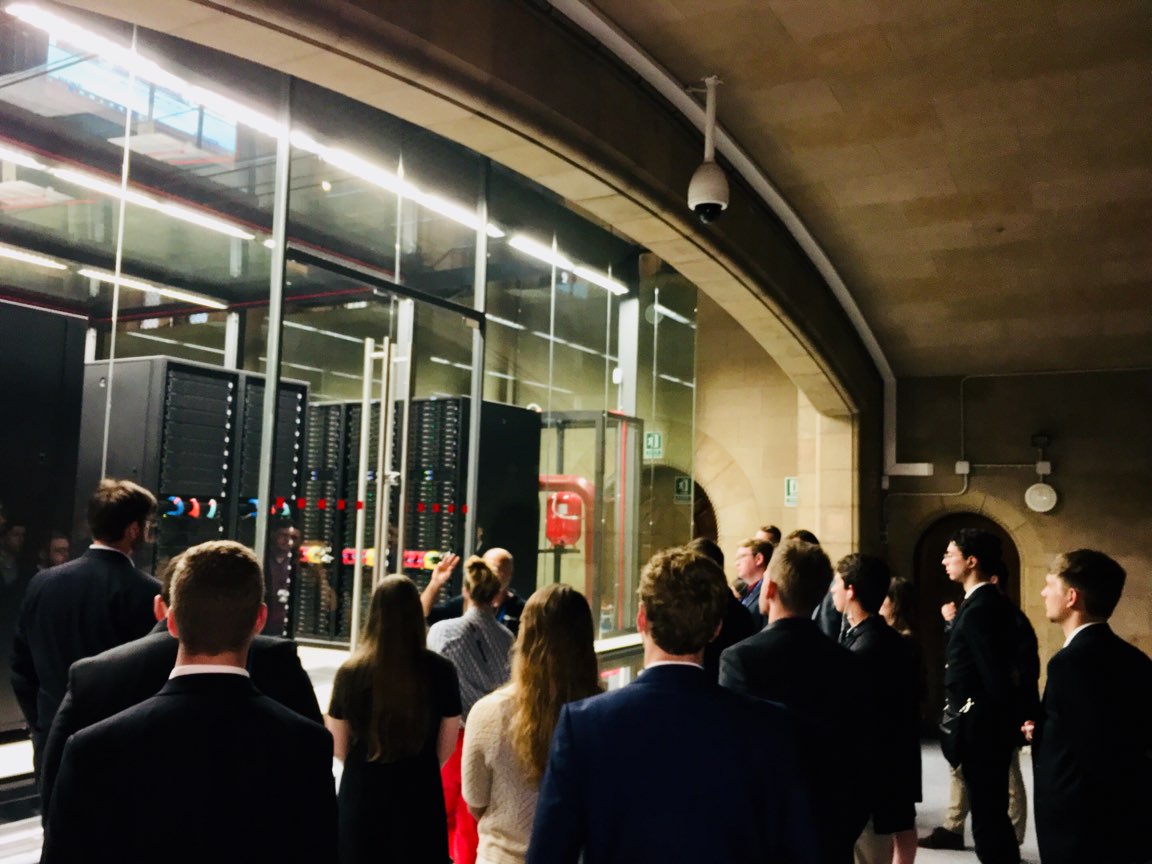
Today marked the last day of our Barcelona company visits. We started out at the Barcelona Supercomputing Center, and got a tour of the MareNostrum 4 supercomputer (pictured here). The computer itself is actually updated every four years to ensure it is providing the research community with top notch computing power. Interestingly enough, the whole operation is housed out of a church.
Our next visit was to Grifols, a pharmaceutical and medical device manufacturer based out of Catalonia. The company has employees all over the world, but 75% of its workforce is US based. Grifols makes blood plasma-based products and the equipment and reagents used in chemical testing. Our guides Marta and Montserrat did a wonderful job of giving us a company overview and history and an extensive facility tour. The class learned a great deal about the governance around the pharmaceutical industry and what it's like to operate a multinational pharma business.
For lunch we journeyed back to downtown Barcelona and had free time to explore the cafes on the waterfront. The views were once again idyllic, thanks to the weather.
Our last visit of the day was to the Freixenet Vineyard. They specialize in making cava, a type of Spanish sparkling wine. Our tour guide took us through all parts of the complex, including the wine cellars and the industrial fermentation areas. We learned about the great deal of preparation required to make cava, including maintenance during all of the seasons of the year and the mixtures of grapes that are brought together to make Freixenet's blends of cava. Our class especially enjoyed the tasting at the end of the tour, where we sampled Brut Nature, the driest cava the company makes (pictured here).
We concluded our day with a group dinner at La Font del Prades Restaurant in the Spanish quarter of the city (pictured here). Our group got the chance to try traditional dishes like Valencian paella and scallop shell fish gratin.
Tomorrow we have a free day to explore Barcelona independently.
Day 9
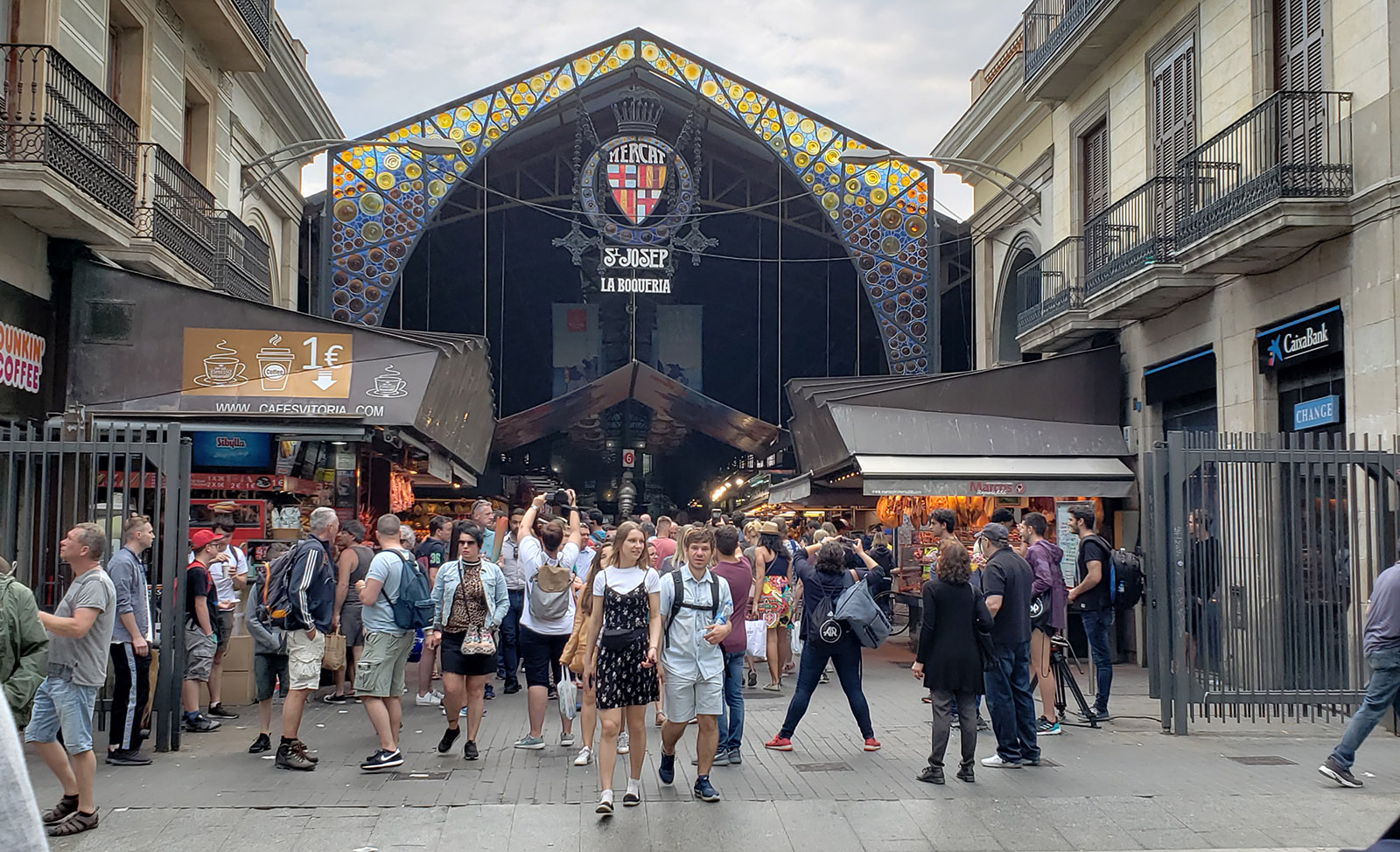
With no scheduled company visits or tours, our group was free to wander Barcelona today. Popular group activities included visiting the Olympic Stadium, Camp Nou, the home stadium of FC Barcelona, and the zoo. A large group also journeyed to the nearby Sitges beaches for some volleyball and much needed sunshine.
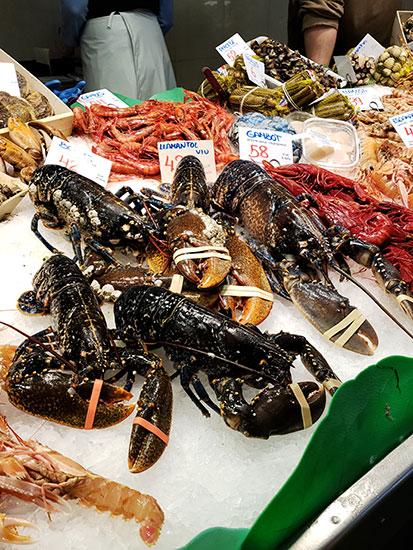 Other groups spent the day shopping exploring street vendors and malls. One Barcelona hub, the Mercat de Sant Josep de la Boqueria, is known for its diverse offerings. It's a large public market right off of the most famous street in Barcelona: La Rambla. You can buy everything from salted nuts and spices to live seafood. Many stalls also offer cheap fresh fruit, including exotic varieties like dragonfruit and whole coconuts. You can also find tons of prepared dishes here, including affordable tapas and freshly baked bread. Attached are a few photos of the market, including the entrance and some fresh fruit and seafood.
Other groups spent the day shopping exploring street vendors and malls. One Barcelona hub, the Mercat de Sant Josep de la Boqueria, is known for its diverse offerings. It's a large public market right off of the most famous street in Barcelona: La Rambla. You can buy everything from salted nuts and spices to live seafood. Many stalls also offer cheap fresh fruit, including exotic varieties like dragonfruit and whole coconuts. You can also find tons of prepared dishes here, including affordable tapas and freshly baked bread. Attached are a few photos of the market, including the entrance and some fresh fruit and seafood.
Day 10
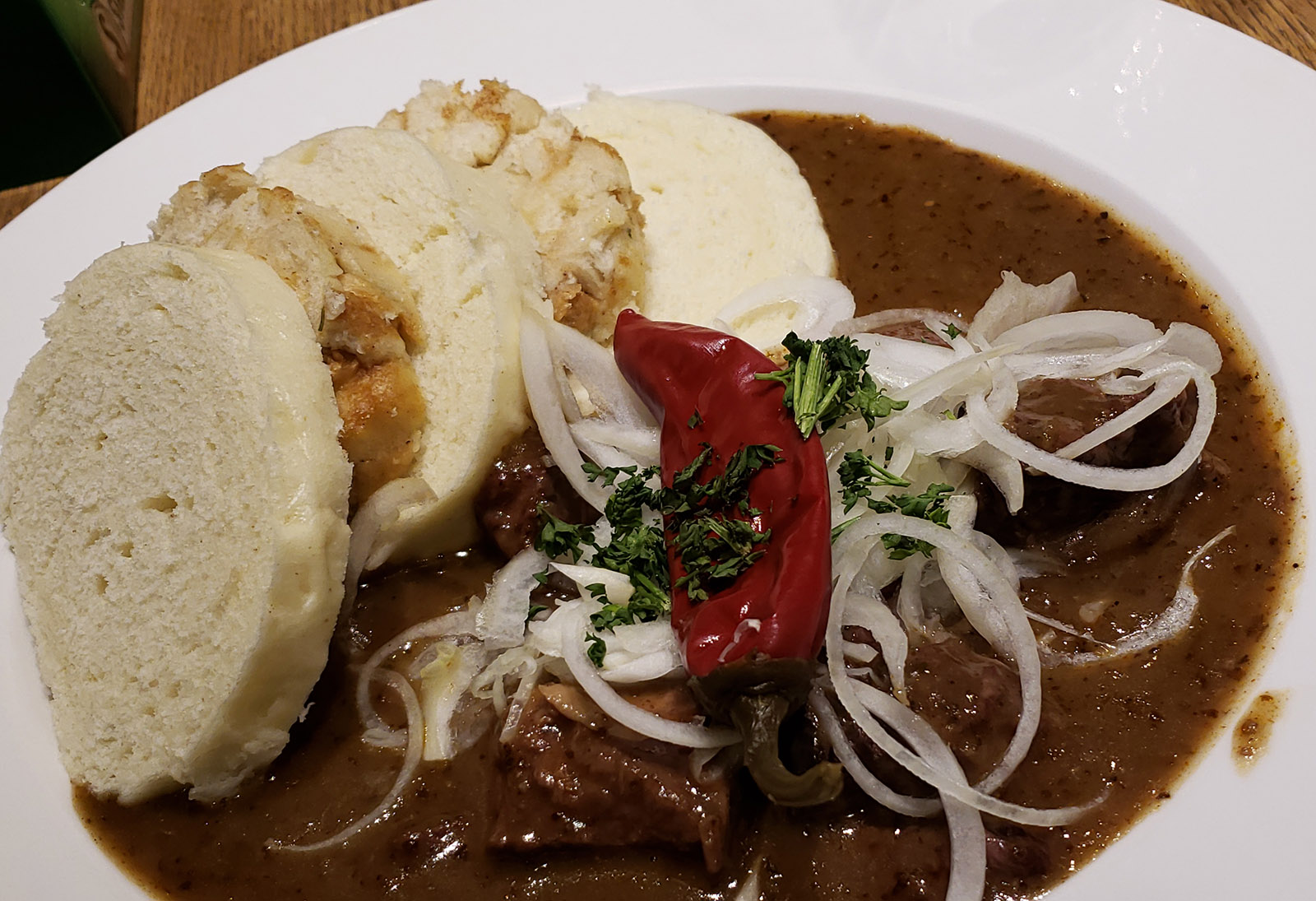
Adéu, Catalunya!
As our time in Barcelona concludes, many of us are sad to leave. The gorgeous weather and delicious food make it difficult to say goodbye to the city, but we are thankful we were able to experience some of the best that Barcelona has to offer, including all the Gaudí works and the engaging company visits.
Today the group had a free morning and many of us spent it packing or doing a much needed load of laundry. We ate lunch at the Barcelona airport in preparation for an afternoon flight to Prague. After a short delay we arrived on time and after checking into the hotel we had free time to explore the city and grab a bite to eat. Maps provided by our guide helped orient us in relation to our hotel and gave us a good indication of how walkable the city is.
Per our guide's recommendation, the main train station actually had very affordable, filling meals, including this Czech beef dish with dumplings and onions (pictured here). The exchange rate for USD to the Czech crown (czk) is favorable, making it an attractive trip. Expect lots of souvenirs to return from the city!
Tomorrow we begin our day with a cultural tour of Prague.
Day 11
Ahoj from Praha!
Our group started the morning with a tour of the city, beginning at Prague castle. The home is the official residence of the President of the Czech Republic, and has armed guards posted at the entrance (pictured here). Our guide informed us of the rigorous selection process used to pick these individuals for the job. It's a highly coveted, respected position but can only be held for five years. You must be in the best physical condition to serve in this capacity, and be willing to stand guard through the elements.
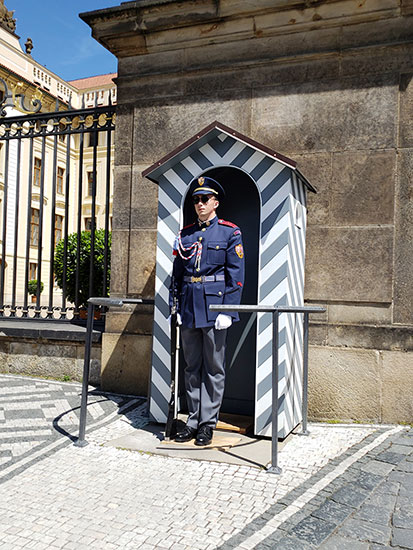 We progressed through the city on foot, walking past St. Vitus Cathedral (pictured here),
We progressed through the city on foot, walking past St. Vitus Cathedral (pictured here),
down the shops on golden lane, through Josefov, the former Jewish ghetto, down through the Old Town, and across the Charles bridge, where Czech artisans and craftspeople set up stands to sell their goods. We learned a great deal about the country from our guide, including the fact that the Czech Republic currently enjoys an unemployment rate of 0.6 percent, the best in the European Union. Overall, it was a very enriching day, and our group enjoyed learning more about a new cultural region of Europe.
Tomorrow begins our first Czech company visits.
Day 12
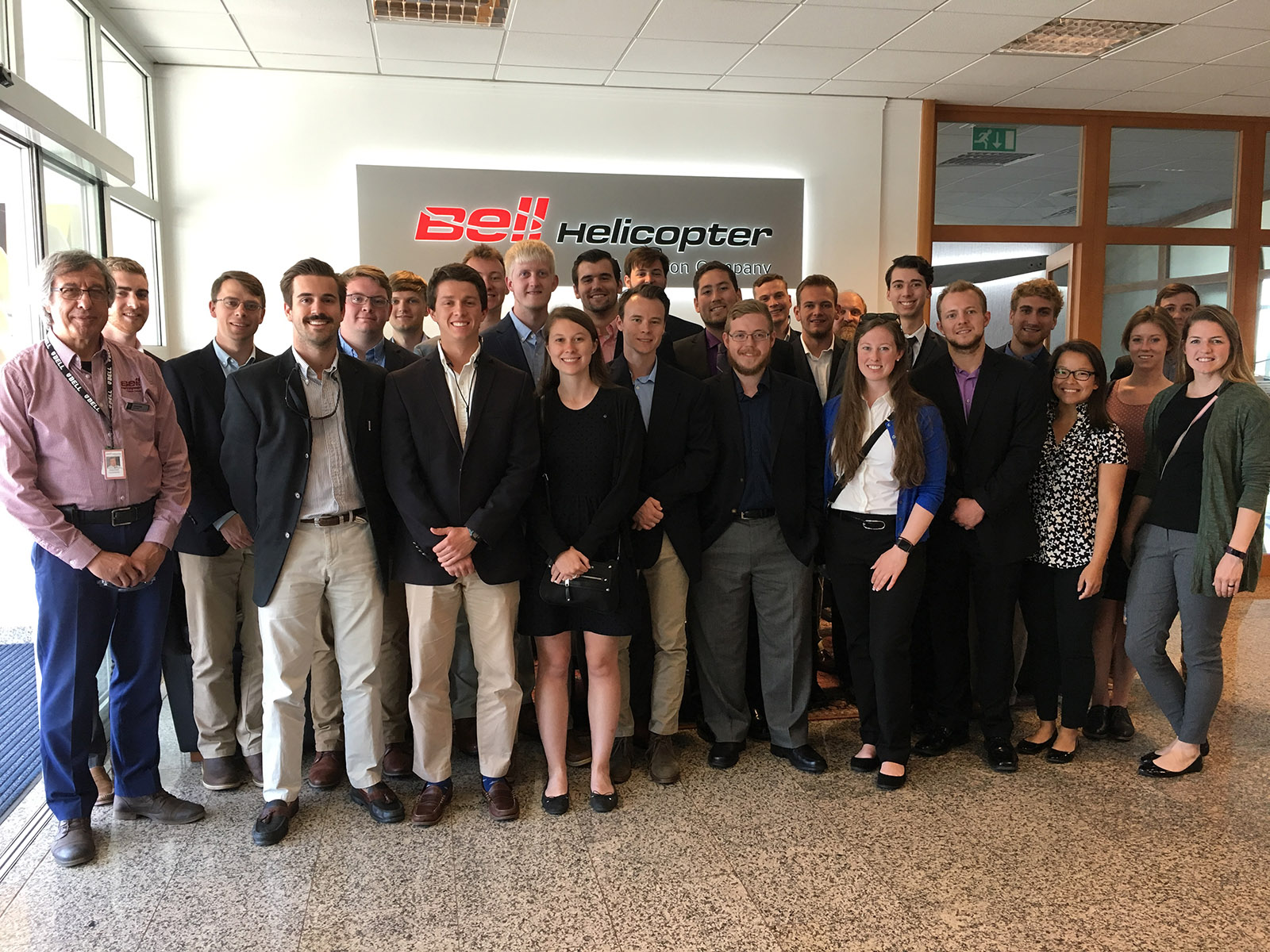
Today's agenda included a visit to Bell Helicoper and a free afternoon. On the way to the company visit, we got to learn more about Czech culture and the country itself. Our guide Yitka informed us that the Czech Republic treats illnesses with spa visits. Doctors can refer their patients to the spas for three weeks and the prescription is covered by insurance. The country is also the second largest producer of cars per capita in Europe. We also got to hear of Yikta's experience as a young adult in school, working to harvest potatoes and hops. She grew up during a period where the schools participated in this as a mandatory requirement for their students. In present day the country does not require participation in agricultural pursuits of this kind.
The visit to Bell Helicopter allowed our group to learn more about the Textron company that produces commercial and military rotorcraft. Although the company is US based, they operate globally but are not an international company. Most of their employees and operations are in the USA. They anticipate the future of the company will be a focus on vertical lifts and drone manufacturing. Our group got the chance to enter the company's hangar and observe some of the current models during the manufacturing process.
During the free afternoon groups explored some of Prague's landmark attractions including the Žižkov Television Tower, Prague Zoo, and the John Lennon wall.
Tomorrow is our last day of the program and although we're sad our time here is ending, we'll keep the memories and lessons of this trip with us for years to come.
Day 13
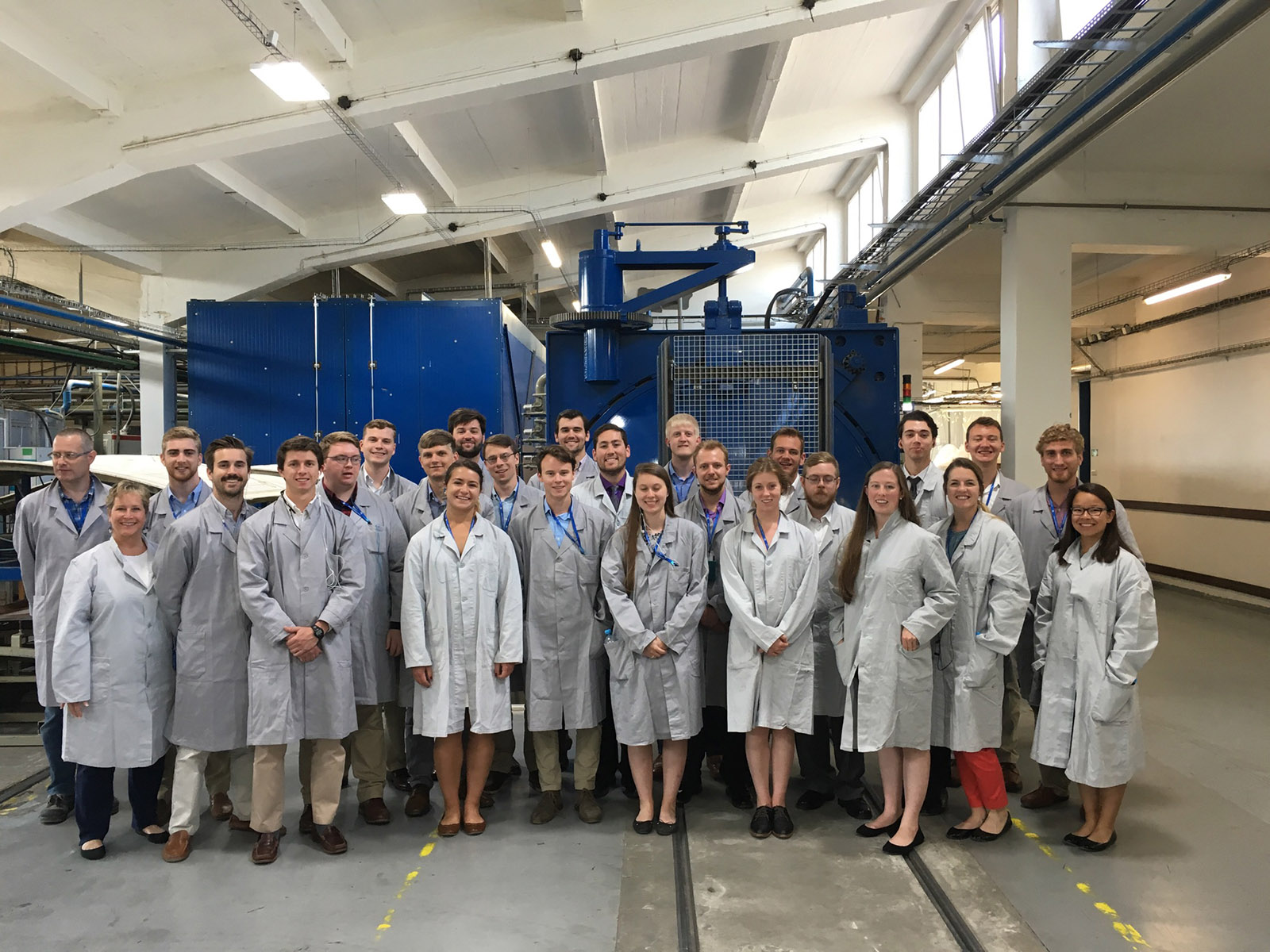
For the last day of the program, we packed in a busy agenda: we visited LA Composites, a materials manufacturer for the aerospace industry, and ELI Beamlines, an international laser research center. At LA composites we heard a lot about the materials manufacturing process for aircraft, and got to tour the highly regulated workspace. We learned about the different structures the company uses for various properties, including honeycomb configuration and carbon fiber materials. At ELI Beamlines, we heard about the history of the research facility itself, from initial concept to funding, and now to construction. We toured the virtual reality room and the visitor gallery to see the laser systems themselves.
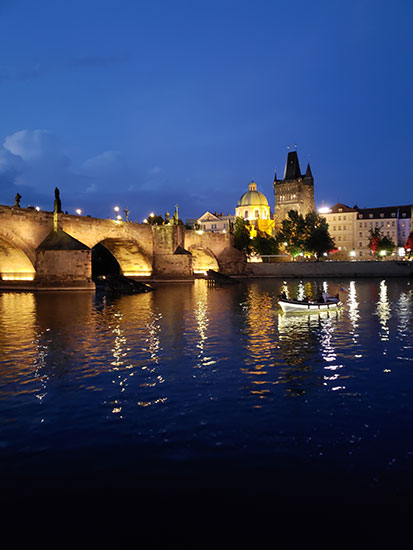 We finished the trip off with a gorgeous dinner cruise under the Prague bridge.
We finished the trip off with a gorgeous dinner cruise under the Prague bridge.
As our trip comes to a close, we realize what a once in a lifetime opportunity this trip has been. From all the cultural tours, business visits, and immersion experiences, it's easy to say we are better equipped to make the best use of our dual degrees now that the trip is over.
On behalf of our entire class, many thanks to Mr. Jim Stuckert for gifting us this amazing experience that we will take with us wherever we go. We are forever grateful. Thanks also to Kim Sayre for her efforts in making this trip happen smoothly.
Safe travels to everyone going home or continuing on their European journeys!